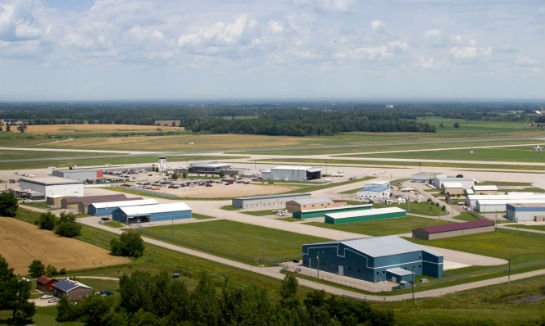Estimated reading time 6 minutes, 1 seconds.
The Region of Waterloo International Airport is Canada’s 37th-busiest airport by passenger volume, with nearly 154,000 passengers last year. Waterloo Airport Photo
Nestled on a rural patch of land just outside the cities of Kitchener and Waterloo, Ont., is Canada’s 37th-busiest airport by passenger volume, a small operation that grew exponentially in the last decade and could grow dramatically in the next few.
This is Region of Waterloo International Airport, a former general aviation facility with nearly 154,000 passengers last year and a potential partner in the drive to meet rising demand for air travel in Southern Ontario.
“We can support many, many more flights than what we have today,” said Chris Wood, the airport’s general manager. “We’re the 10th-largest community in the country, but the 37th-busiest airport as far as passengers. So there’s a disconnect there.”
Southern Ontario is growing so significantly that regional demand for air travel will cause airports to start to approach capacity by the mid-2030s, according to a report from the Greater Toronto Airports Authority (GTAA), which runs Toronto Pearson International Airport. A conservative estimate predicts about 65 million passengers per year at Pearson alone by that time and 90 million passengers or more throughout the region of Southern Ontario by 2043.
Waterloo identifies just over two million passengers a year within 35 kilometres of its airport but only captures about four per cent of traffic from that area. Waterloo Airport Photo
The total annual capacity across all airports in Southern Ontario is estimated at just 70 million, even with planned capacity investments at Pearson, prompting the GTAA to propose a collaborative solution in which airports can work together to accommodate passenger demand, which could involve airports taking on niche roles and services.
“Ten airports from Kingston to Windsor, including Waterloo, have all come together and started to do some thinking around, how can we collectively serve this demand that’s coming,” said Siobhan Desroches, senior communications advisor for the GTAA. “We’re still in the initial stages,” she added. “Each airport’s looking at, what are their strengths and how can they contribute to a regional airport model?”
The GTAA report points to the multi-airport system in New York and New Jersey as an example, where John F. Kennedy, Newark Liberty, La Guardia, Stewart, Teterboro and Atlantic City airports each play a distinct role. It also pointed to the London city-region, which includes London Heathrow, Stansted, Luton, Gatwick and London City airports; and the Paris city-region that relies on both Charles de Gaulle and Paris-Orly airports.
“If we keep on operating independently, without coordination, we’re not going be able to manage the same capacity that we would if we work together,” said Desroches.
Waterloo identifies just over two million passengers a year within 35 kilometres of its airport but only captures about four per cent of traffic from that area. A majority of passengers use Pearson, and Wood sees an opportunity to attract more of those travellers in the years ahead.
As Southern Ontario approaches capacity for air travel, regional airports may play a larger role. Waterloo Airport Photo
Waterloo offers daily, non-stop flights to Calgary with WestJet and twice-daily, non-stop flights to Chicago via American Airlines.
WestJet also offered weekly flights to Orlando, Fla., from December to late April and is expected to offer Orlando flights again next winter.
Sunwing Airlines is offering weekly seasonal service from Waterloo to Punta Cana, Dominican Republic, from Dec. 22, 2016 to March 2017.
NextJet Canada is set to provide daily air service between Waterloo and Peterborough, Ottawa/Gatineau and Montreal starting on May 30, 2016.
But a limited number of airline routes may explain why Waterloo has not captured more regional customers.
“If I owned a variety store and I only had two items on the shelf, I’d only get a certain number of customers,” said Wood. “But if I had more items on my shelf, I’m going to get more of the market share.
“So we fully believe, 100 per cent, without a doubt, the more destinations that airlines serve from our airport, the greater the passengers will be.”
Waterloo is actively trying to attract other airlines–Wood identified that as his main focus. He argues in favour of high-speed rail linking regional airports with Pearson, another suggestion included in the GTAA report.
Ultimately, he sees a massive opportunity for growth.
“Ninety-five per cent of people who want to fly go somewhere else,” he said. “So we think there’s a massive opportunity to repatriate a lot of those people today.”





